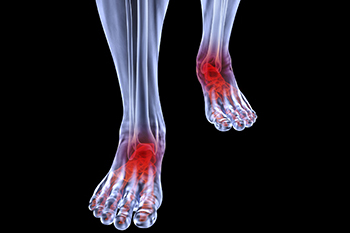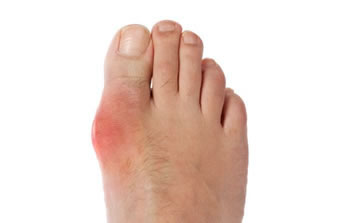
Conditions affecting the feet due to complications with arthritis can take many forms, including osteoarthritis, rheumatoid arthritis, gout, psoriatic arthritis, and ankylosing spondylitis. Osteoarthritis typically affects the joint connecting your big toe to your foot, though it can also be found in the midfoot or ankle region. Unlike osteoarthritis, rheumatoid arthritis typically affects both feet and deals with the same joints on each foot. Gout, which normally affects the big toe, is comprised of needle-like crystals that trigger inflammation in the joints. Psoriatic arthritis causes sausage-like swelling in the toes. Lastly, ankylosing spondylitis can lead to plantar fasciitis and pain at the Achilles tendon.
Many factors play a role in the cause for arthritic feet, including obesity, the aging process, as well as family history or genetic connections to arthritis.To help prevent issues with your feet, examine your feet daily, keep your feet clean, routinely moisturize your feet, keep your toenails trimmed, inspect your shoes for anything that may cause discomfort, and wear socks on a daily basis.
If you’re experiencing any discomfort or pain due to one of the above forms of arthritis, consider over-the-counter pain medication and investing in comfortable footwear. Pain medication coupled with top of the line comfort footwear is a great way to ease the pain that often comes with arthritis. If you’re overweight, it’s also recommended to think about setting a weight loss goal to ease some of the pressure on your feet, as well stay as active as possible. Applying ice or heat to the affected area is another way to calm the discomfort you may experience. It’s important to do research and see whether inserts may be beneficial for you. General foot care, like pampering your feet and keeping them well maintained, is also recommended. Lastly, you should seek professional advice and learn about potential surgery options, if necessary.
Gout

Gout, typically found in diabetic patients, is an unusually painful form of arthritis caused by elevated levels of uric acid in the bloodstream. The condition typically strikes the big joint on the big toe. It has also been known to strike the knees, elbows, fingers, ankles and wrists-generally anywhere that has a functioning, moving joint.
The high level of uric acid in a person’s bloodstream creates the condition known as hyperuricema-the main cause of gout. Genetic predisposition occurs in nine out of ten sufferers. The children of parents who suffer gout will have a two in ten chance of developing the condition as well.
This form of arthritis, being particularly painful, is the leftover uric acid crystallizing in the blood stream. The crystallized uric acid then travels to the space between joints where they rub, causing friction when the patient moves. Symptoms include: pain, redness, swelling, and inflammation. Additional side effects may include fatigue and fever, although reports of these effects are very rare. Some patients have reported that pain may intensify when the temperature drops, such as when you sleep.
Most cases of gout are easily diagnosed by a podiatrist’s assessment of the various symptoms. Defined tests can also be performed. A blood test to detect elevated levels of uric acid is often used as well as an x-ray to diagnose visible and chronic gout.
Treatment for gout simply means eliminating symptoms. Non-steroid anti-inflammatory drugs or NSAIDs (Colchicine and other corticosteroid drugs, etc.) will quell the redness, the swelling, and the inflammation. However, managing your diet, lifestyle changes, and using preventative drugs are all helpful toward fully combating the most severe cases.
Those that lead an inactive lifestyle are at a higher risk for gout. Any amount of exercise decreases the probability of repeat encounters with the condition. Reducing your consumption of red meat, sea food, and fructose-sweetened drinks also reduces the likelihood of chronic gout as well.
Ingesting Vitamin C, coffee, and particular dairy products can help with maintaining a healthy lifestyle. There are new drugs out on the market that inhibit the body’s production of uric acid-producing enzymes. However, reducing or eliminating your overall levels of uric acid is the best remedy to ensuring you lead a gout-free life.
For an official diagnosis and information on treatment options, consult with a podiatrist.
